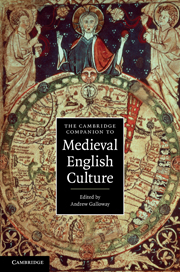Book contents
- Frontmatter
- Introduction
- Part one Theaters of culture: political, legal, material
- Part two Cultural ideals and cultural conflicts
- Part Three Literacies, languages, and literatures
- 7 Visual texts in post-Conquest England
- 8 Literacy, schooling, universities
- 9 Anglo-Latin literature in the later Middle Ages
- 10 The vernaculars of medieval England, 1170-1350
- 11 English literary voices, 1350-1500
- Part four Legacies and re-creations
- Guides to further reading
- Index
7 - Visual texts in post-Conquest England
from Part Three - Literacies, languages, and literatures
Published online by Cambridge University Press: 28 July 2011
- Frontmatter
- Introduction
- Part one Theaters of culture: political, legal, material
- Part two Cultural ideals and cultural conflicts
- Part Three Literacies, languages, and literatures
- 7 Visual texts in post-Conquest England
- 8 Literacy, schooling, universities
- 9 Anglo-Latin literature in the later Middle Ages
- 10 The vernaculars of medieval England, 1170-1350
- 11 English literary voices, 1350-1500
- Part four Legacies and re-creations
- Guides to further reading
- Index
Summary
Seeing with medieval eyes is impossible for us. Yet we can try to use medieval descriptions of images – ekphrastic passages – as “medieval spectacles“ to correct the distortions of our modern vision. A famous passage from the first version of Gerald of Wales' Topographia Hibernica (Topography of Ireland), finished early in 1188, describes with notable care the illuminations in a Gospel Book reputed to have been miraculously made nearly 500 years earlier, which Gerald says he saw on a visit to Kildare:
Among all the miracles of Kildare nothing seems to me more miraculous than that wonderful book which they say was written at the dictation of an angel during the lifetime of the virgin [St. Brigit]. This book contains the four gospels according to the concordance of St. Jerome, with almost as many drawings as pages, and all of them in marvellous colours. Here you can look upon the face of the divine majesty drawn in a miraculous way; here too upon the mystical representations of the Evangelists, now having six, now four, and now two, wings. Here you will see the eagle; there the calf. Here the face of a man; there that of a lion. And there are almost innumerable other drawings. If you look at them carelessly and casually and not too closely, you may judge them to be mere daubs rather than careful compositions. You will see nothing subtle where everything is subtle. But if you take the trouble to look very closely, and penetrate with your eyes to the secrets of the artistry, you will notice such intricacies, so delicate and subtle, so close together and well-knitted, so involved and bound together, and so fresh still in their colourings that you will not hesitate to declare that all these things must have been the result of the work, not of men, but of angels.
- Type
- Chapter
- Information
- The Cambridge Companion to Medieval English Culture , pp. 147 - 171Publisher: Cambridge University PressPrint publication year: 2011
- 3
- Cited by



